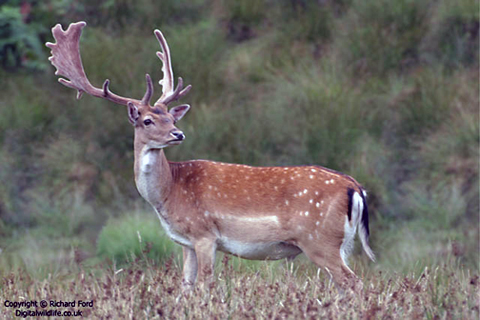My NAME is Alice, but –”
“It’s a stupid name enough!” Humpty Dumpty interrupted impatiently.
“What does it mean?”
“MUST a name mean something?” Alice asked doubtfully.
“Of course it must,” Humpty Dumpty said with a short laugh:
“MY name means the shape I am—and a good handsome shape it is, too.
With a name like yours, you might be any shape, almost.
Like most of their contemporaries, Lewis and Clark used the word fallow mainly in reference to the color of the Virginia whitetail. Few, probably, had ever seen a picture of a European fallow deer, and may have been unaware that this species’ distinctive antlers were palmated, or flattened, not round like those of indigenous North American deer.
The most conspicuous feature that the Virginia whitetail shared with the European fallow deer was its spotted coat. But that is true only for the first year of the Virginian’s life, whereas the European species retains its spots all its life. In both cases the spots serve as camouflage by dissolving part of the animal’s outline against a sun-dappled forest understory.
European fallow deer were among the first mammals to be deliberately introduced into non-native habitats, beginning several hundred years ago. Even though most 21st-century North Americans still are unfamiliar with them, they are the best known and most widely distributed “park deer” the world around.
The first man in the Corps to shoot a deer for its meat was John Colter, at Camp Dubois on 30 December 1804. Reubin Field was second, eight days later, and on 19 January 1804, George Gibson killed three more. At least 15 more were shot during the last week in January, then no more were mentioned until late May. After leaving St. Charles the captains began regularly dispatching the hunters with the horses, and by early June deer became more plentiful, and plenty were killed—sometimes as many as 10 per day, all of the familiar Virginia whitetail breed. It was not until 5 September 1804, when the first mule deer—”Deer with black tales,” Clark wrote—were sighted. Ten days passed, and as they penetrated the eastern boundary of the dark gray mule deer’s range, the journalists began to mention them separately.
During the 18th century the word fallow had two meanings. The one that is most common today, which came from the Old English word fealh, first appeared in print early in the 14th century, denoting a cultivated field that is permitted to lie unplanted for a full growing season. The other meaning, derived from the Old English word fealu, which was in use from the 9th through the 19th century and is now obsolete, denoted a color—sometimes described as brownish-yellow, reddish-yellow, yellowish-red, or “a pale red colour, like that of a brick half burnt, such as that of a fallow-deer.”[1]A. F. Gotch, Latin Names Explained (New York: Facts on File, 1995); American Heritage Dictionary, Fourth Edition, 1992; Oxford English Dictionary Online; A New and Complete Dictionary of Arts and … Continue reading
In this second sense, the name “fallow deer” appeared in print early in the 16th century as the designation for the most common European species of deer, which in the 18th century was classified by scientists under the Latin generic name, Dama, meaning “deer,” and the species dama. The binomial could be translated as “deer of all deer.”
At about that same time they encountered a deer that resembled a Virginia whitetail but had a noticeably longer tail (eventually identified by zoologists as Odocoleus virginianus dacotensis, or “Virginia white-tails of the Dakotas.”) On 16 September 1804, in the vicinity of “Pleasant Camp” near today’s Oacoma, South Dakota, Clark wrote that Sergeant Gass and Reubin Field reported seeing “Deer of three kinds . . . [including?] The fallow Deer.” Evidently the three were mule deer, Virginia whitetail, and long-tailed Virginia whitetail. On the 17th Clark wrote that “the hunters brought in 8 fallow Deer & 5 Common Deer to day.” Otherwise and elsewhere, fallow and common belonged together as one name, as in “one common fallow or longtailed deer” (Lewis, 10 May 1805), or “the common fallow deer with the long tail” (both Clark and Lewis, 28 March 1806).
Thus was spun a tangled tale of names.
Notes
| ↑1 | A. F. Gotch, Latin Names Explained (New York: Facts on File, 1995); American Heritage Dictionary, Fourth Edition, 1992; Oxford English Dictionary Online; A New and Complete Dictionary of Arts and Sciences (London: Printed for W. Owen, 1764). The last-named source, commonly referred to as “Owen’s Dictionary,” was carried in the Lewis and Clark expedition’s small reference library. |
|---|

